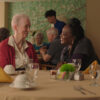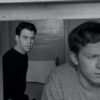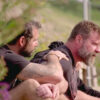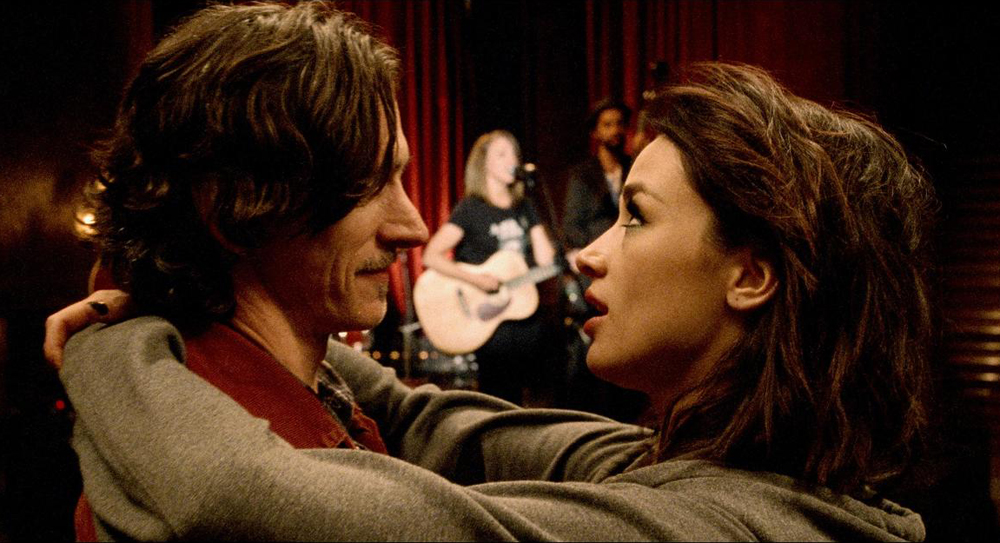Last summer at the Los Angeles Film Festival where “Too Late” premiered, special arrangements needed to be made for Dennis Hauck’s feature debut. While most attendees filed into Regal Cinemas at the LA Live across town, the Bing Theater at the Los Angeles County Museum of Art filled with cinephiles where Hauck’s film unspooled in celluloid, something now impossible at many of theaters in the heart of Hollywood. Since then, Hauck still hasn’t created a digital copy of “Too Late” – after all, he’d come this far, initially conceiving the story of a bemused and occasionally bruised private investigator (John Hawkes) on the hunt for a missing young woman named Dorothy (Crystal Reed) around the idea of five 20-minute acts that would run for only as many frames as a single reel would allow.
Yet the mystique of “Too Late” isn’t exclusively its scarcity, but rather what it does with each of those 20,000-frame single, continuous takes, casting a spell as it wanders through the fringes of Los Angeles from its plasticine mansions to underground boxing rings, with cozy blues clubs, drive-in theaters and hillside vistas thrown into the mix as Hawkes’ dogged detective Mel Sampson pieces together what happened. With an intentionally jumbled narrative where Sampson is just as likely to run into Dorothy’s fragile family (played in riveting turns by Natalie Zea and Joanna Cassidy) as a vengeance-minded old lady (Vail Bloom) of a mob boss (Robert Forster) so angry she forgets to wear pants, “Too Late” may disorient at first, yet the chemical alchemy that Hauck surely enjoys so much about the 35mm film he shoots on would seem to extend to the way in which “Too Late” activates a movie lover’s neurons, cruising through harrowing melodrama to cool noir to gripping gangster tale with the same smoothness as Sampson’s old reliable Trans-Am.
While Hauck is currently in New York as part of a nationwide tour with the film, he spoke about how “Too Late” was born out of limitations, as well as making sure he wasn’t stealing equipment from the U.S. military, embracing the many curveballs that came his way during production and appreciating the fact the film is a bit of an enigma.

That’s an interesting question. I do have mixed feelings because there’s just so many movies being made today, I guess the 35mm thing is something that sets us apart from the pack, especially the way we’re releasing it, only on 35mm, no DCP, and anything that gets people to see this movie, I’m for. But you’re right, it does distract from the story, which I’m very proud of. Even in Q&As, most of the questions are technical and they’re about how did you pull off the long takes,” and so I do always get very happy any time someone asks me anything about the characters. I do worry there’s a lot of people that can be blinded by style or they can’t see that maybe I care just as much about the story as I do the way I told the story in these long takes. My favorite movies are usually a blend of style and substance, but I’ve seen this happen with some of my favorite movies, that I would get mad at the reviews that people would dismiss them as just being stylistic exercises. It happens somewhat with Too Late as well, but maybe [people] show up for the 35mm but walk away hopefully having seen a good story that sticks with them and haunts them.
You’ve said that the length of the film reels dictated how long each scene would play – 20 minutes – but what came first, the story or the idea that you’d be shooting this on film?
They were a little concurrent but I was thinking about multiple stories of what I was going to write next at the time, and I had this idea. What dictated a lot of it would be the 20-minute reels – I did an interview with someone recently and they put it so much better than I ever had, [which is that] I put these self-imposed limitations on and that can lead you in very interesting creative directions that you wouldn’t have gotten to otherwise, and the interviewer said, “Almost like a poet choosing to write a Haiku,” because poets do that all the time. The content can be anything, but it has to fit in five syllables, seven syllables and five syllables, or whatever the case may be.

A little bit. What’s interesting about it is that the story would not have existed if I didn’t have all these limitations, either self-imposed or otherwise, because I knew we weren’t going to have a lot of money. So I started [thinking], “Where can I set these scenes and get the most bang for my buck?” or “What’s a very cinematic location?” So I did look – I was living in Laurel Canyon at the time and if I walked up my street for about half a mile, I would reach Mulholland Drive and I just remember the feeling of always coming up over the hill and all of a sudden there just being the valley below, seeing the whole city laid out. It was just such an impressive location and we didn’t shoot there, but that idea of a hilltop that really appealed to me. Or I’d be driving by Barstow and I’d see this beautiful drive-in in the middle of nowhere and I just thought, “Oh, I would love to set something in the drive-in.” Maybe that’s a backwards way of going about it, but I’m happy because it led me to whatever the story of “Too Late” is.
The sequence on the hill is such an impressive way to open the film with a God’s eye point of view, not only following the characters in the foreground but an apartment building way off in the distance as if you’re looking through binoculars, but logistically was it difficult to get all that?
Definitely, and that lens took a long time. I wrote the whole scene and I thought, “Wow, it would be great to find a really long lens and just zoom in to the city and find John Hawkes answering the phone on the other end,” and basically that was a lens that only existed in my mind. When we went to look around at lenses, it became clear that there wasn’t one for cinema that would do that. I even looked up what Kubrick used on those great long zooms in “Barry Lyndon” and that wasn’t even half of the distance we needed, so we started looking into broadcast lenses that are used at sporting events. Ultimately, we ended up with this lens that there’s only a couple of in existence – they’re made by Ingenue and mainly used by the Navy for offshore surveillance. We actually had to make sure that the Navy wasn’t using this lens when we were shooting. Then we had to figure out a way to kind of Jerry-rig it to a film camera because it wasn’t made for [that use], so it took a lot of planning.

It was usually about 10 takes per scene. We almost invariably ended up using the last take of the day, just because everyone was so dialed in and we knew the sun was going down, or the sun was coming up and just the whole crew knew, “Okay, this is our last chance to really knock it out of the park.” Three out of the five scenes were the last take of the day.
Because of the nature of this, I’d expect you’d have to embrace the unexpected that might happen during a 20-minute take. Was there anything you were happy made it into the film that you hadn’t planned for?
Yeah, there’s actually one line that was flubbed by an actor, which I’m not going to tell you, but it gets a laugh and no one thinks it’s unintentional. The way I wrote it was very boring and in the middle of a 20-minute take, [the actor] fumbled the line, but the result is wonderful and I wish I had written it. But there’s always just little moments you don’t anticipate.
One of my favorites is when John Hawkes leaves the strip club and he walks down the street to go into that honky tonk where Sally Jaye is playing and that ended up being the crucial moment of the movie. Our poster is from that moment. The composer based his entire score around that – like he said, “I need to write a piece for this moment, for him walking down the sidewalk, and then everything else will fall into place.” But that was just one line in the script, [which] said “Sampson exits the strip club and walks down the street to another bar.” And it’s like his one moment by himself, reflecting, but there was something about it, and I think it was John – he turns around and acknowledges the guy he just punched and he gives him that little “Right on, brother” fist pump, which was not expected at all – so that was just something he brought to it. Invariably, in a 20-minute scene, there are going to be things that you don’t account for. Sometimes it’s stuff that you don’t like, but often it’s stuff that surprises you and is really nice.

Almost all of them – every role, except for Dorothy, [where] I wanted to find someone new, and, actually, we ended up casting [Crystal Reed] the lead of the “Teen Wolf” show, which I didn’t intend to, but she was so good, we had to cast her. But aside from that, it was like the locations. I knew we wouldn’t have a lot of money, so I wrote roles for people that I either knew personally or that I had some connection to that I thought maybe I could get the script to them. Not all of them ended up working out, but about half of the roles did go to the people that I wrote them for. A few of them were friends. I used to live next door to Rider Strong in Laurel Canyon and Dichen Lachman is a friend of mine, because we had done a short film together. The guy that plays the park ranger, Brett Jacobsen, is a friend, so I wrote all of that for them, just gave them the scripts and said, “Here. You’re cast.”
Natalie Zea, who plays Carrie, was someone I knew and that was actually the third role I had offered her, but she came in, not just the 11th hour, but the 13th hour – she was cast the day of [shooting] and she was absolutely amazing. We had someone cast in that role for over a year that dropped out on us at the last moment, so we were just really scrambling and finally it was like, “Natalie, we need someone. Can you please come in here and do this?” And she just steals the show, but the whole crew was already on set. She just showed up like, “Oh, what am I doing here? A 15-minute take?” And she killed it.

They all had their own unique challenges. The one that intimidated me the most was Act Two at the mansion because most of the movie is usually two people talking and I felt like I could handle that. But that scene is five people all yelling on top of each other and I knew that it was going to be veteran actors and I’m a first-time director, so we had all these guys together with so much experience and then we had to figure out how to even cover them. “The camera’s got to be flying back and forth – where do I put the camera?” I had to have answers for these guys that had seen it all and now they’re doing this weird experiment with some long take, shouting on top of each other for 20 minutes.
Because these scenes were shot over the course of a two-year period and you’d have time between them, did you rethink the next based on what you had shot before?
I’m sure I did. At the time, I was wishing we could have just shot them all back-to-back and I never thought it would take this long to make the movie. I’m sure that if I had shot one of the last scenes that we did right away [after the other] it would have been a very different scene, because there was so much downtime. All the actors, the crew and even the producers went off and did other projects, except me. This was my life and I just sat there trying to figure out, “Well, how can we shoot this next scene?”
But it did give me time to go back. The script didn’t change significantly, but there were probably dialogue tweaks and minor things, but a lot of the music came to me during that period. Some of it I thought of in the script-writing stage, like the Nick Cave song that [Vail Bloom’s] Janet sings in the mirror when she’s getting changed. But some of it… I was driving around in my car listening to records for two years and all of a sudden a song would come to me and I’d be like, “Oh, wow, I’ve never realized this is just like Sampson and Jill and what they’re going through. Maybe I can use this in the movie somehow.”
Is the post-production on this actually fairly easy given that what you’ve got is in the can and you don’t really need to edit it?
Well, choosing the takes was the hard thing, and of course, there was no perfect take for any of them. I was always slightly tempted to hide a digital cut, but ultimately I just felt like that would be cheating. I couldn’t do that, but it was so tempting because you knew this [one] take is overall the best scene, but at one little moment it’s not quite as strong as in another take when when there’s such a little magical moment there and if I could somehow put them together and actually edit, like most movies do… But you kind of had to stop looking at all the takes and just go with one. Once I picked a take, it was straight to sound design, which we spent a lot of time on because that was really our only way to be creative in the post-production process.

Oh, cool, yeah, there was so much going on there. There’s two movies playing and we’re hearing the sounds from those movies and there’s the crowd and the ticket girl who’s making announcements throughout. We would do things where there’s all these people and some of them aren’t even paying attention to the movie – they’re just there to hang out, which happens at drive-ins a lot – so they’ve got music blasting out of their car. To make it all sound realistic and like the camera is traveling by these sound sources definitely took a lot of work.
Because of your insistence of showing this on 35mm, these screenings of the film have seemed to become real events wherever it’s played. What’s it been like to travel with it?
It’s still crazy to me, this being my first movie. I’ve done film festivals before and that’s great, but it’s still crazy to me that today my movie’s playing five times [a day] in LA and Austin, [and now I’m in New York], it’s playing 10 times somewhere and I’m not there. You’re used to being there to present the movie and talk about it, and now, in a couple weeks we’ll be playing dozens of screens, five times a day and it’s very weird to not be there. But I guess that’s what having a real movie in theaters is.
It’s been fun to be able to travel as much as possible and hear what people say. I’m sure there’s people that don’t like it, but typically, the ones that come up to me like it a lot and some of them go back and see it multiple times, which is what I always hoped for. My favorite movies are the ones that you see something new every time you watch it. There’s a lot of movies that I like that [I think], “Okay, I think I got it on that one watch. I don’t really need to watch it again,” but I hope I was making a movie that people would find value in in repeat viewings.
“Too Late” is now playing in Los Angeles at the Sundance Sunset and in New York at the Village East Cinema. It will expand on April 8th. A full schedule of cities and dates is here.




